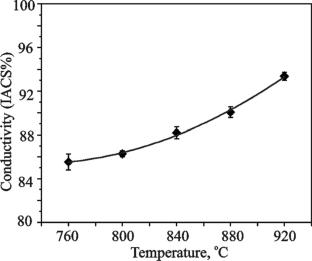Cu matrix composites have received increased attention in a wide industrial area because of their excellent mechanical properties and good electrical and thermal conductivity. However, the addition of general ceramic reinforcements often leads to a marked reduction in electrical conductivity for Cu matrix composites. In this study, the ZrB2-reinforced Cu composites have been developed to overcome this drawback since these metal borides possess relatively high electrical conductivity. The 5 wt.% ZrB2/Cu composites were prepared using hot-pressed sintering techniques at varying temperatures from 760 to 920°C. The influence of sintering temperature on the microstructure, relative density, and mechanical and electrical properties was examined. The results of the SEM observation show that ZrB2 particles are seamlessly integrated into the Cu matrix for all ZrB2/Cu composites. The average grain size of the Cu matrix increases from 360 to 980 nm with the increase of the sintering temperature. The increase in sintering temperature also leads to the surface porosity decrease from 1.4 to 0.4%. The relative density and electric conductivity of the composites increase at the same time as the sintering temperature increases. However, microhardness increases and decreases, with a maximum value of 92 HV0.2 achieved at 840°C. The elastic modulus and nanohardness maps determined from the nanoindentation indicate that the reinforced ZrB2 particles demonstrate the highest values for elastic modulus (340–500 GPa) and nanohardness (30–48 GPa). At the same time, the Cu matrix possesses a modulus of 100–200 GPa and nanohardness of about 10 GPa. TEM observation confirmed that the sintering temperature exhibits little influence on the interface reaction between ZrB2 and Cu. Both sharp interface and interface with amorphous transition layer are observed. The variation of microhardness is mainly due to the strengthening of grain refinement and to the mismatch of the thermal expansion coefficients. The above results can provide further insights into the deeper understanding of the role of sintering temperature during hot-pressed sintering.



